Tingwen Liu
Hyperbolic-PDE GNN: Spectral Graph Neural Networks in the Perspective of A System of Hyperbolic Partial Differential Equations
May 29, 2025Abstract:Graph neural networks (GNNs) leverage message passing mechanisms to learn the topological features of graph data. Traditional GNNs learns node features in a spatial domain unrelated to the topology, which can hardly ensure topological features. In this paper, we formulates message passing as a system of hyperbolic partial differential equations (hyperbolic PDEs), constituting a dynamical system that explicitly maps node representations into a particular solution space. This solution space is spanned by a set of eigenvectors describing the topological structure of graphs. Within this system, for any moment in time, a node features can be decomposed into a superposition of the basis of eigenvectors. This not only enhances the interpretability of message passing but also enables the explicit extraction of fundamental characteristics about the topological structure. Furthermore, by solving this system of hyperbolic partial differential equations, we establish a connection with spectral graph neural networks (spectral GNNs), serving as a message passing enhancement paradigm for spectral GNNs.We further introduce polynomials to approximate arbitrary filter functions. Extensive experiments demonstrate that the paradigm of hyperbolic PDEs not only exhibits strong flexibility but also significantly enhances the performance of various spectral GNNs across diverse graph tasks.
* 18 pages, 2 figures, published to ICML 2025
Graph Wave Networks
May 26, 2025Abstract:Dynamics modeling has been introduced as a novel paradigm in message passing (MP) of graph neural networks (GNNs). Existing methods consider MP between nodes as a heat diffusion process, and leverage heat equation to model the temporal evolution of nodes in the embedding space. However, heat equation can hardly depict the wave nature of graph signals in graph signal processing. Besides, heat equation is essentially a partial differential equation (PDE) involving a first partial derivative of time, whose numerical solution usually has low stability, and leads to inefficient model training. In this paper, we would like to depict more wave details in MP, since graph signals are essentially wave signals that can be seen as a superposition of a series of waves in the form of eigenvector. This motivates us to consider MP as a wave propagation process to capture the temporal evolution of wave signals in the space. Based on wave equation in physics, we innovatively develop a graph wave equation to leverage the wave propagation on graphs. In details, we demonstrate that the graph wave equation can be connected to traditional spectral GNNs, facilitating the design of graph wave networks based on various Laplacians and enhancing the performance of the spectral GNNs. Besides, the graph wave equation is particularly a PDE involving a second partial derivative of time, which has stronger stability on graphs than the heat equation that involves a first partial derivative of time. Additionally, we theoretically prove that the numerical solution derived from the graph wave equation are constantly stable, enabling to significantly enhance model efficiency while ensuring its performance. Extensive experiments show that GWNs achieve SOTA and efficient performance on benchmark datasets, and exhibit outstanding performance in addressing challenging graph problems, such as over-smoothing and heterophily.
* 15 pages, 8 figures, published to WWW 2025
Mitigating Modality Bias in Multi-modal Entity Alignment from a Causal Perspective
Apr 29, 2025



Abstract:Multi-Modal Entity Alignment (MMEA) aims to retrieve equivalent entities from different Multi-Modal Knowledge Graphs (MMKGs), a critical information retrieval task. Existing studies have explored various fusion paradigms and consistency constraints to improve the alignment of equivalent entities, while overlooking that the visual modality may not always contribute positively. Empirically, entities with low-similarity images usually generate unsatisfactory performance, highlighting the limitation of overly relying on visual features. We believe the model can be biased toward the visual modality, leading to a shortcut image-matching task. To address this, we propose a counterfactual debiasing framework for MMEA, termed CDMEA, which investigates visual modality bias from a causal perspective. Our approach aims to leverage both visual and graph modalities to enhance MMEA while suppressing the direct causal effect of the visual modality on model predictions. By estimating the Total Effect (TE) of both modalities and excluding the Natural Direct Effect (NDE) of the visual modality, we ensure that the model predicts based on the Total Indirect Effect (TIE), effectively utilizing both modalities and reducing visual modality bias. Extensive experiments on 9 benchmark datasets show that CDMEA outperforms 14 state-of-the-art methods, especially in low-similarity, high-noise, and low-resource data scenarios.
S1-Bench: A Simple Benchmark for Evaluating System 1 Thinking Capability of Large Reasoning Models
Apr 14, 2025



Abstract:We introduce S1-Bench, a novel benchmark designed to evaluate Large Reasoning Models' (LRMs) performance on simple tasks that favor intuitive system 1 thinking rather than deliberative system 2 reasoning. While LRMs have achieved significant breakthroughs in complex reasoning tasks through explicit chains of thought, their reliance on deep analytical thinking may limit their system 1 thinking capabilities. Moreover, a lack of benchmark currently exists to evaluate LRMs' performance in tasks that require such capabilities. To fill this gap, S1-Bench presents a set of simple, diverse, and naturally clear questions across multiple domains and languages, specifically designed to assess LRMs' performance in such tasks. Our comprehensive evaluation of 22 LRMs reveals significant lower efficiency tendencies, with outputs averaging 15.5 times longer than those of traditional small LLMs. Additionally, LRMs often identify correct answers early but continue unnecessary deliberation, with some models even producing numerous errors. These findings highlight the rigid reasoning patterns of current LRMs and underscore the substantial development needed to achieve balanced dual-system thinking capabilities that can adapt appropriately to task complexity.
SOTOPIA-Ω: Dynamic Strategy Injection Learning and Social Instrucion Following Evaluation for Social Agents
Feb 21, 2025Abstract:Despite the abundance of prior social strategies possessed by humans, there remains a paucity of research dedicated to their transfer and integration into social agents. Our proposed SOTOPIA-{\Omega} framework aims to address and bridge this gap, with a particular focus on enhancing the social capabilities of language agents. This framework dynamically injects multi-step reasoning strategies inspired by negotiation theory, along with two simple direct strategies, into expert agents, thereby automating the construction of high-quality social dialogue training corpus. Additionally, we introduce the concept of Social Instruction Following (S-IF) and propose two new S-IF evaluation metrics that are complementary to social capability. We demonstrate that several 7B models trained on high-quality corpus not only significantly surpass the expert agent (GPT-4) in achieving social goals but also enhance S-IF performance. Analysis and variant experiments validate the advantages of dynamic construction, which can especially break the agent's prolonged deadlock.
Inner Thinking Transformer: Leveraging Dynamic Depth Scaling to Foster Adaptive Internal Thinking
Feb 19, 2025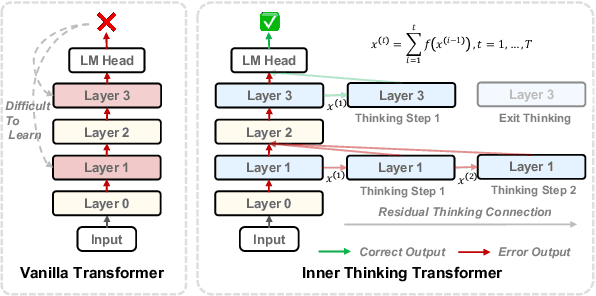
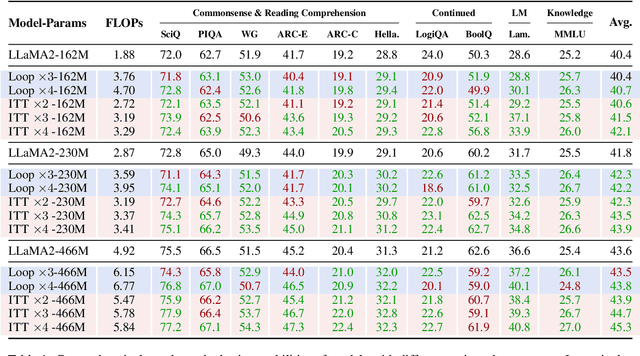
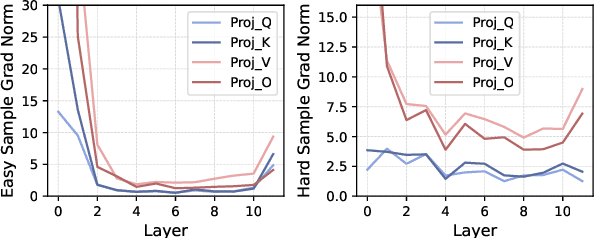
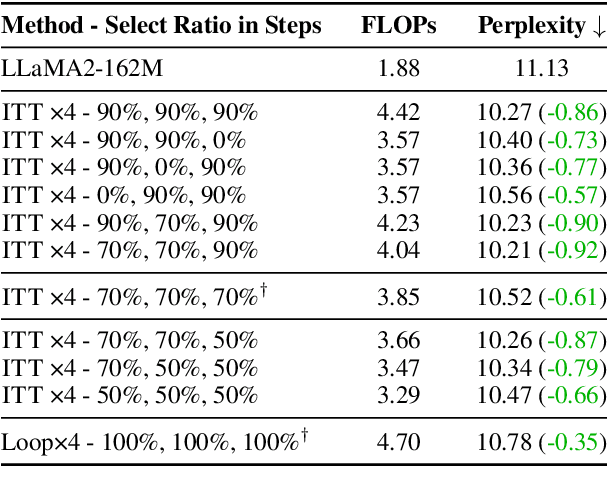
Abstract:Large language models (LLMs) face inherent performance bottlenecks under parameter constraints, particularly in processing critical tokens that demand complex reasoning. Empirical analysis reveals challenging tokens induce abrupt gradient spikes across layers, exposing architectural stress points in standard Transformers. Building on this insight, we propose Inner Thinking Transformer (ITT), which reimagines layer computations as implicit thinking steps. ITT dynamically allocates computation through Adaptive Token Routing, iteratively refines representations via Residual Thinking Connections, and distinguishes reasoning phases using Thinking Step Encoding. ITT enables deeper processing of critical tokens without parameter expansion. Evaluations across 162M-466M parameter models show ITT achieves 96.5\% performance of a 466M Transformer using only 162M parameters, reduces training data by 43.2\%, and outperforms Transformer/Loop variants in 11 benchmarks. By enabling elastic computation allocation during inference, ITT balances performance and efficiency through architecture-aware optimization of implicit thinking pathways.
FARM: Frequency-Aware Model for Cross-Domain Live-Streaming Recommendation
Feb 13, 2025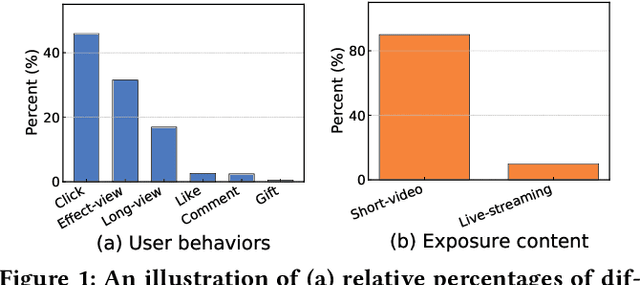

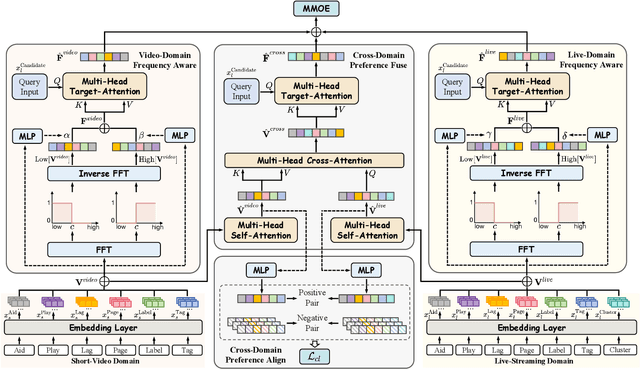

Abstract:Live-streaming services have attracted widespread popularity due to their real-time interactivity and entertainment value. Users can engage with live-streaming authors by participating in live chats, posting likes, or sending virtual gifts to convey their preferences and support. However, the live-streaming services faces serious data-sparsity problem, which can be attributed to the following two points: (1) User's valuable behaviors are usually sparse, e.g., like, comment and gift, which are easily overlooked by the model, making it difficult to describe user's personalized preference. (2) The main exposure content on our platform is short-video, which is 9 times higher than the exposed live-streaming, leading to the inability of live-streaming content to fully model user preference. To this end, we propose a Frequency-Aware Model for Cross-Domain Live-Streaming Recommendation, termed as FARM. Specifically, we first present the intra-domain frequency aware module to enable our model to perceive user's sparse yet valuable behaviors, i.e., high-frequency information, supported by the Discrete Fourier Transform (DFT). To transfer user preference across the short-video and live-streaming domains, we propose a novel preference align before fuse strategy, which consists of two parts: the cross-domain preference align module to align user preference in both domains with contrastive learning, and the cross-domain preference fuse module to further fuse user preference in both domains using a serious of tailor-designed attention mechanisms. Extensive offline experiments and online A/B testing on Kuaishou live-streaming services demonstrate the effectiveness and superiority of FARM. Our FARM has been deployed in online live-streaming services and currently serves hundreds of millions of users on Kuaishou.
Exploring Preference-Guided Diffusion Model for Cross-Domain Recommendation
Jan 20, 2025

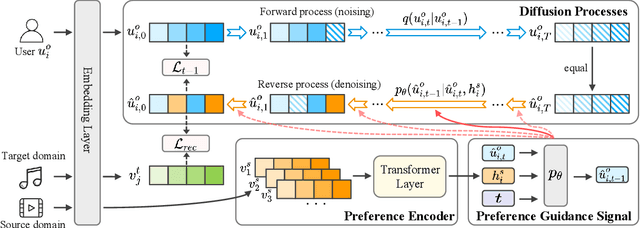

Abstract:Cross-domain recommendation (CDR) has been proven as a promising way to alleviate the cold-start issue, in which the most critical problem is how to draw an informative user representation in the target domain via the transfer of user preference existing in the source domain. Prior efforts mostly follow the embedding-and-mapping paradigm, which first integrate the preference into user representation in the source domain, and then perform a mapping function on this representation to the target domain. However, they focus on mapping features across domains, neglecting to explicitly model the preference integration process, which may lead to learning coarse user representation. Diffusion models (DMs), which contribute to more accurate user/item representations due to their explicit information injection capability, have achieved promising performance in recommendation systems. Nevertheless, these DMs-based methods cannot directly account for valuable user preference in other domains, leading to challenges in adapting to the transfer of preference for cold-start users. Consequently, the feasibility of DMs for CDR remains underexplored. To this end, we explore to utilize the explicit information injection capability of DMs for user preference integration and propose a Preference-Guided Diffusion Model for CDR to cold-start users, termed as DMCDR. Specifically, we leverage a preference encoder to establish the preference guidance signal with the user's interaction history in the source domain. Then, we explicitly inject the preference guidance signal into the user representation step by step to guide the reverse process, and ultimately generate the personalized user representation in the target domain, thus achieving the transfer of user preference across domains. Furthermore, we comprehensively explore the impact of six DMs-based variants on CDR.
Mixture of Hidden-Dimensions Transformer
Dec 10, 2024



Abstract:Transformer models encounter challenges in scaling hidden dimensions efficiently, as uniformly increasing them inflates computational and memory costs while failing to emphasize the most relevant features for each token. For further understanding, we study hidden dimension sparsity and observe that trained Transformers utilize only a small fraction of token dimensions, revealing an "activation flow" pattern. Notably, there are shared sub-dimensions with sustained activation across multiple consecutive tokens and specialized sub-dimensions uniquely activated for each token. To better model token-relevant sub-dimensions, we propose MoHD (Mixture of Hidden Dimensions), a sparse conditional activation architecture. Particularly, MoHD employs shared sub-dimensions for common token features and a routing mechanism to dynamically activate specialized sub-dimensions. To mitigate potential information loss from sparsity, we design activation scaling and group fusion mechanisms to preserve activation flow. In this way, MoHD expands hidden dimensions with negligible increases in computation or parameters, efficient training and inference while maintaining performance. Evaluations across 10 NLP tasks show that MoHD surpasses Vanilla Transformers in parameter efficiency and task performance. It achieves 1.7% higher performance with 50% fewer activation parameters and 3.7% higher performance with a 3x parameter expansion at constant activation cost. MOHD offers a new perspective for scaling the model, showcasing the potential of hidden dimension sparsity to boost efficiency
MoR: Mixture of Ranks for Low-Rank Adaptation Tuning
Oct 17, 2024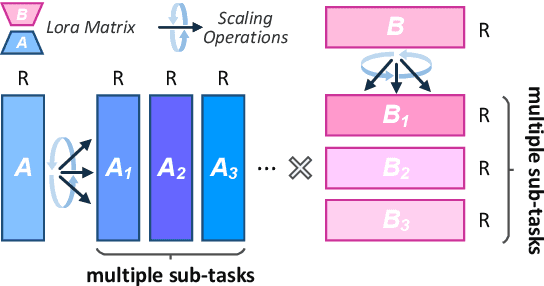
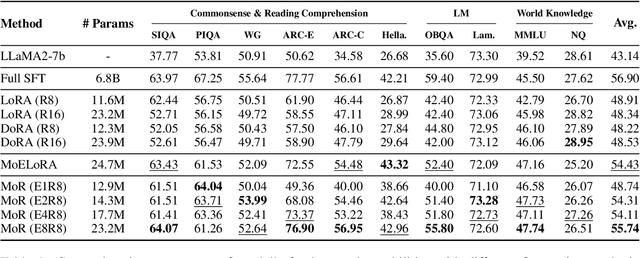

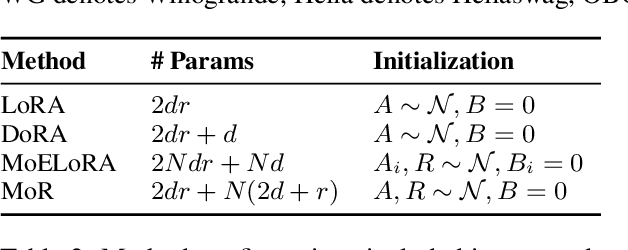
Abstract:Low-Rank Adaptation (LoRA) drives research to align its performance with full fine-tuning. However, significant challenges remain: (1) Simply increasing the rank size of LoRA does not effectively capture high-rank information, which leads to a performance bottleneck.(2) MoE-style LoRA methods substantially increase parameters and inference latency, contradicting the goals of efficient fine-tuning and ease of application. To address these challenges, we introduce Mixture of Ranks (MoR), which learns rank-specific information for different tasks based on input and efficiently integrates multi-rank information. We firstly propose a new framework that equates the integration of multiple LoRAs to expanding the rank of LoRA. Moreover, we hypothesize that low-rank LoRA already captures sufficient intrinsic information, and MoR can derive high-rank information through mathematical transformations of the low-rank components. Thus, MoR can reduces the learning difficulty of LoRA and enhances its multi-task capabilities. MoR achieves impressive results, with MoR delivering a 1.31\% performance improvement while using only 93.93\% of the parameters compared to baseline methods.
 Add to Chrome
Add to Chrome Add to Firefox
Add to Firefox Add to Edge
Add to Edge